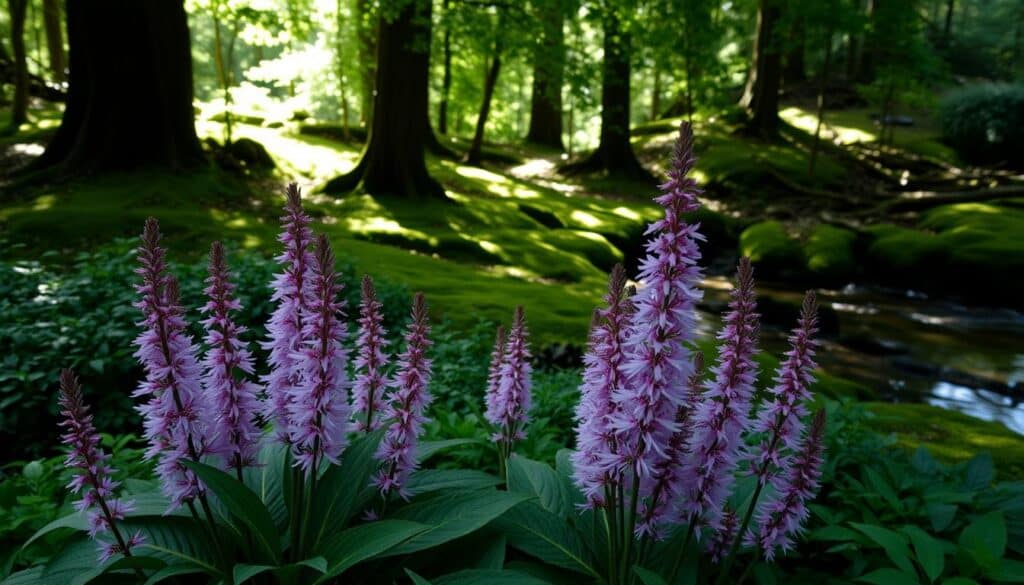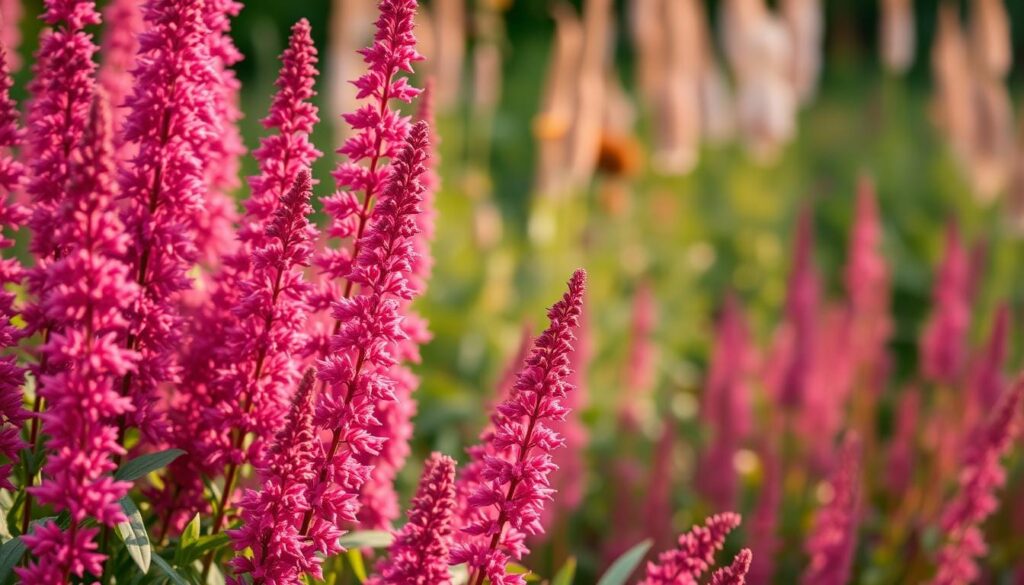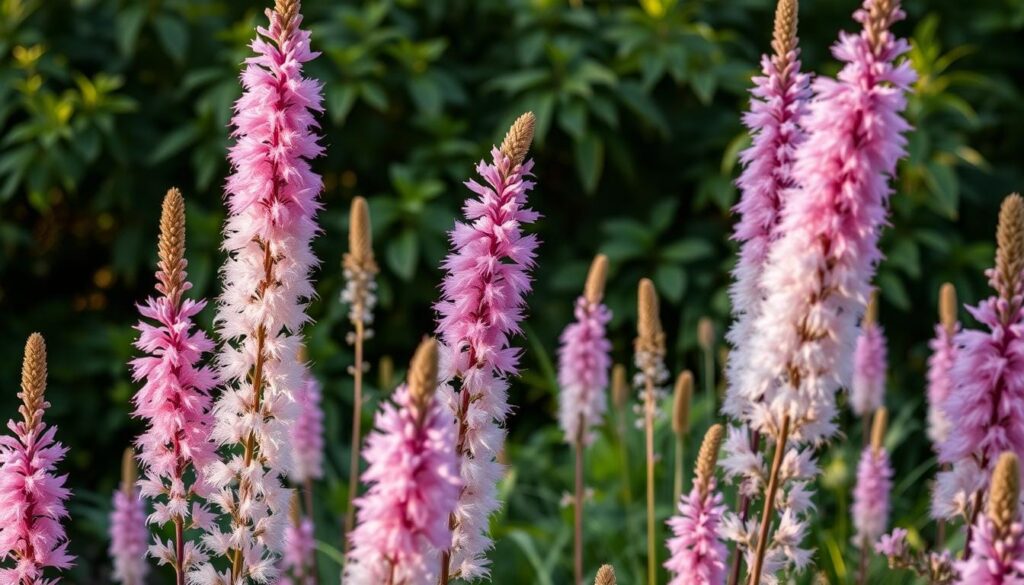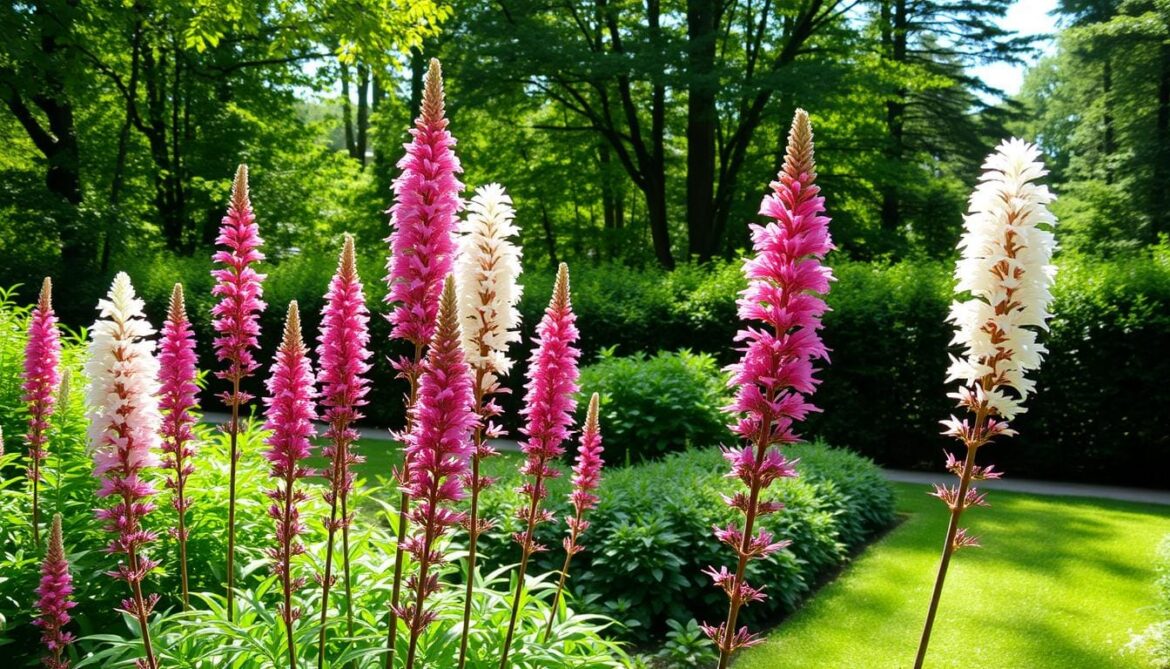Imagine a garden where shade-loving perennials thrive, adding vibrant color and delicate texture to the landscape. For many gardeners, achieving this vision can be challenging, especially in areas with limited sunlight. However, with the right plants, this dream can become a reality.
Astilbe varieties have become a staple in perennial gardens, thanks to their hardiness and ability to produce long-lasting flowers in shady conditions. Their feathery plumes add a unique texture to the garden, making them a valuable addition to any landscape.
To ensure these beautiful plants continue to flourish, understanding their specific needs and maintenance requirements is crucial. By providing the right conditions and care, gardeners can enjoy their Astilbe flowers throughout the season, surrounded by lush foliage.
Key Takeaways
- Choose the right Astilbe variety for your garden’s specific conditions.
- Understand the specific growing conditions required for optimal Astilbe performance.
- Learn how to maintain your Astilbe plants throughout the growing season.
- Discover tips for incorporating Astilbe into your garden design.
- Find out how to care for Astilbe plants during the off-season.
Discovering Tall Astilbe Varieties for Your Garden
For gardeners looking to add some drama to their shade garden, tall astilbe varieties are an excellent choice. These statuesque plants can reach impressive heights, creating a striking vertical interest in the garden.
Most Popular Tall Astilbe Cultivars
The most sought-after tall astilbe cultivars include ‘Purple Candles,’ ‘Purple Blaze,’ ‘White Glory,’ and ‘Bridal Veil.’ Each of these varieties offers unique color and growth characteristics, making them suitable for different garden settings. You can explore more astilbe varieties on PBN Design.
Distinctive Features and Bloom Colors
Tall astilbe varieties are known for their feathery plumes, which come in a range of colors including pure white, deep purple, pink, red, and salmon. The distinctive bloom colors and foliage characteristics make them a great addition to perennial borders and woodland garden edges. Some cultivars, like ‘Bridal Veil,’ feature bronze-tinted leaves, adding additional visual interest to the garden.
When selecting tall astilbe varieties, consider both the flower color and the bloom time, as different cultivars flower at slightly different periods throughout the summer. This ensures a dynamic display of colors throughout the growing season.
Creating the Perfect Growing Environment

To ensure the optimal growth of tall astilbe plants, it’s crucial to create a suitable growing environment. This involves understanding their requirements for shade, soil composition, and moisture.
Shade and Light Requirements
Tall astilbe plants thrive in partially shaded locations, receiving morning sun and afternoon shade. They can tolerate more sun in cooler climates if provided with consistent moisture. The shade tolerance of tall astilbes makes them valuable for difficult north-facing garden areas or spots under deciduous trees.
Soil Composition and pH
The ideal soil for tall astilbes is rich in organic matter, slightly acidic with a pH between 5.5 and 6.5, and retains moisture while offering good drainage. Incorporating compost or well-rotted manure improves soil fertility and moisture retention.
Water and Moisture Needs
Consistent moisture is crucial for tall astilbe plants, as they naturally grow in woodland environments. Water requirements increase during the active growing season, needing approximately 1-2 inches of water weekly. However, they will not tolerate standing water or waterlogged soil conditions.
| Growing Condition | Ideal Requirement |
|---|---|
| Shade and Light | Partial shade to full shade |
| Soil Composition | Rich in organic matter, slightly acidic (pH 5.5-6.5) |
| Water and Moisture | Consistent moisture, 1-2 inches water weekly |
For more detailed information on growing astilbe, visit https://www.gardendesign.com/plants/astilbe.html.
5 Essential Care Tips for Tall Astilbe

To keep your tall astilbe plants thriving, it’s essential to follow a few key care tips. Proper care ensures that these beautiful perennials continue to add texture and beauty to your garden.
1. Proper Planting Techniques
When planting tall astilbe, space them 18-24 inches apart to accommodate their mature height and spread, allowing for adequate air circulation between plants. This spacing helps prevent diseases and promotes healthy growth.
2. Watering Schedule
Establish a consistent watering schedule to maintain even soil moisture, especially during the first growing season and summer flowering periods. This helps the plants stay healthy and thrive.
3. Fertilization Guidelines
Fertilize tall astilbe in early spring with a balanced, slow-release fertilizer or compost tea. This supports healthy growth without promoting excessive foliage at the expense of flowers.
4. Mulching Benefits
Apply a 2-3 inch layer of organic mulch around tall astilbe plants to conserve soil moisture, suppress weeds, and gradually add organic matter to the soil as it breaks down.
5. Pest and Disease Management
Monitor plants regularly for signs of common issues like powdery mildew or leaf spot. Ensure good air circulation and avoid overhead watering to prevent these problems. Tall astilbes are generally deer-resistant, making them a great choice for gardens with deer pressure.
| Care Tip | Description | Benefit |
|---|---|---|
| Proper Planting Techniques | Space plants 18-24 inches apart | Prevents disease and promotes growth |
| Watering Schedule | Maintain even soil moisture | Keeps plants healthy and thriving |
| Fertilization Guidelines | Fertilize in early spring | Supports healthy growth and flowering |
| Mulching Benefits | Apply 2-3 inches of organic mulch | Conserves moisture and suppresses weeds |
| Pest and Disease Management | Monitor plants regularly | Prevents common issues like powdery mildew |
Seasonal Maintenance Calendar for Tall Astilbe

Maintaining tall astilbe plants requires a seasonal approach to ensure they thrive in your garden. Understanding the needs of these plants at different times of the year is crucial for their health and beauty.
Spring Preparation and Early Care
In the spring, remove winter mulch and cut back any remaining foliage from the previous season to make way for new growth. As new foliage emerges, apply a balanced slow-release fertilizer to support the season’s growth and eventual bloom production.
Summer Blooming Period Maintenance
During the summer, consistent watering is crucial during the blooming period, typically from June through July. Consider installing support stakes for particularly tall cultivars to prevent flopping in summer rainstorms. The height of tall astilbe varieties makes them susceptible to damage.
Fall Clean-up and Division
In the fall, cut back foliage after it has died back naturally, typically after the first frost has browned the leaves. Division of tall astilbe plants is best performed in early spring or fall every 3-4 years to maintain vigor and prevent overcrowding that can reduce flowering.
Winter Protection Strategies
For winter protection, apply a layer of mulch after the ground freezes to prevent frost heaving, particularly important in regions with fluctuating winter temperatures. This simple step helps ensure the plants remain healthy through the cold season.
| Season | Maintenance Task | Timing |
|---|---|---|
| Spring | Remove mulch, cut back foliage, fertilize | Early Spring |
| Summer | Water consistently, provide support | June-July |
| Fall | Cut back foliage, divide plants | After first frost |
| Winter | Apply mulch | After ground freezes |
Conclusion
The versatility and beauty of tall Astilbe make them a standout in garden landscapes. Tall Astilbe varieties offer gardeners a perfect combination of impressive height, distinctive plumes, and shade tolerance, making them invaluable perennials for challenging garden spaces.
The wide selection of tall Astilbe cultivars provides options in various colors, including white, pink, red, salmon, and lavender, allowing gardeners to find perfect matches for their landscape designs. With proper care focused on consistent moisture, appropriate shade levels, and seasonal maintenance, tall Astilbes will return reliably year after year with increasing beauty and impact.
By selecting varieties with different bloom times, gardeners can extend the flowering season from early to late summer, maximizing the color impact these impressive perennials provide. Whether used as specimen plants, in mass plantings, or as components in mixed perennial beds, tall Astilbe varieties earn their place in the garden through their reliability, low maintenance needs, and striking beauty.
Tall Astilbes deserve consideration in any garden design where their qualities would enhance the landscape, offering a rare combination of being deer-resistant and producing abundant flowers in shaded conditions.

